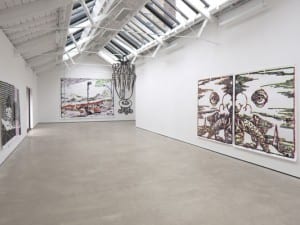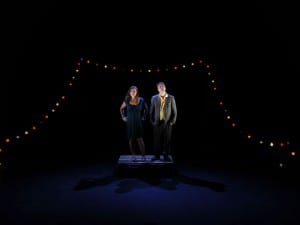Simon Starling has been revisiting the history of forms and objects for two decades, creating installations, films, photographs and sculptures that unearth connections across space and time. His Glasgow exhibition, Nine Feet Later, includes a series of site-specific daguerreotypes titled Recursive Plates – an ongoing series that Starling began in 2014 in Mexico. The Recursive Plates are made for and in particular spaces – in this case, The Modern Institute’s Aird’s Lane gallery space.
The daguerreotype process is one of the earliest techniques for making photographic images and was developed in France by Louis Daguerre in the 1830s. Each of these daguerreotypes has been produced on a highly polished, mirror-like sheet of silver-plated metal and each surface now holds a ghostly echo of the recent exhibition history of the space in which it was made and is now exhibited. The now phantasmagorical works that jostle for position on the reflective surfaces of the Recursive Plates have themselves been re-photographed from a number of fixed camera positions. These images orchestrate a form of temporal overlay that connects the space’s past with its present and with the sculptural element of the exhibition, which occupies the space in front of the photographs.
Taking its starting point from a nine-foot long sheet of Japanese cedar wood veneer on which two Japanese scene painters were invited to paint an image of a length of bamboo (the world’s fastest growing timber), the title work Nine Feet Later is a loose assemblage of affiliated objects that constitute a time machine of sorts. Along with the fast growing bamboo (some varieties grow at 90cm a day), sits the trace of a 15 million year old tree trunk, a nine-foot long piece of petrified wood, turned to stone.
Somewhat younger is a plank of 45,000 year old Ancient Kauri wood, pickled for millennia in a New Zealand swamp, and here transformed into 9ft of Gerrit Rietveld’s Zig-Zag Chair (a still-futuristic design from 1932-34). Together with an octagonal oak housing, a powerful reflecting telescope, and a copy of a birch branch – which, unlike the petrified tree trunk, was deposited layer by layer in a matter of hours in a high-tech 3D printing machine – this collection of objects begins a conversation with the artworks from the recent past of the exhibition space reiterated on the mirrored surfaces of the Recursive Plates.
Starling, born in the UK in 1967, won the Turner Prize in 2005 and was shortlisted for the 2004 Hugo Boss Prize.
Simon Starling, Nine Feet Later, until 6 February, The Modern Institute, 3 Aird’s Lane, Glasgow.
Find out more: www.themoderninstitute.com.
Follow us on Twitter @AestheticaMag for the latest news in contemporary art and culture.
Credits
1. Simon Starling, Nine Feet Later, 2015. Installation view, The Modern Institute, 3 Aird’s Lane, Glasgow.





